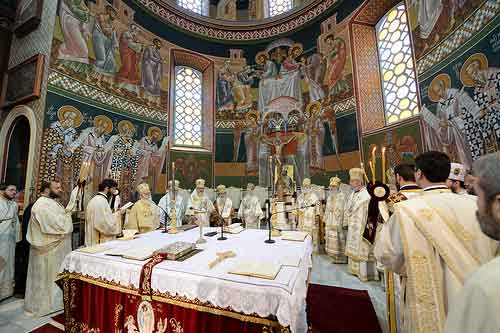
A friend pointed to the above image and exclaimed: “Now, that’s liturgy!”
True.
Very quickly, however, in our one-way culture (where affirming one thing is understood by many as denying anything different to what is being affirmed), people end up thinking that the above image is the only way to do liturgy, the ideal of liturgy we should be aiming for.
But I contend that the following image is just as much, “Now, that’s liturgy!”:

Liturgy is prayer, worship together; praying in Christ; as part of the Body of Christ.
This means liturgy needs to be appropriate to the context. The image at the top of this post is of His All-Holiness Ecumenical Patriarch Bartholomew presiding over the Divine Services of Pentecost and concelebrating with the Primates of the Local Orthodox Churches at St. Menas Cathedral in Heraklion, Crete. It is the first such meeting for over a millennium. It is one of the grandest possible occasions in Christian history.
But attempting to replicate that in a rural parish church with a dozen people is inappropriate. As would be replicating what happens in such a small community at the current meeting in Crete.
Liturgy is not a cookie-cutter concept, not something we clone (or attempt to clone) from one context into a quite different one.
A couple praying together, “Now, that’s liturgy!”:

It is a nonsense, an oxymoron, to talk about “non-liturgical worship”. That’s like saying “non-eatable food”, “invisible colour”… Someone who says, “I don’t like liturgy” is just saying “I don’t like praying”.
Even when you pray alone you pray in Christ, part of the Body of Christ, part of the Communion of Saints. When you pray, you are not alone. And this can be expressed by sharing in the Daily Office, the Daily Eucharistic Readings, the Lord’s Prayer,…

If you want to think through more on making liturgy appropriate to the particular context in which you worship, I encourage you to start with my (free, online) book Celebrating Eucharist.
If you appreciated this post, do remember to like the liturgy facebook page, use the RSS feed, and sign up for a not-very-often email, …



Can you capture liturgy in a photograph?!
Historically we have referred to the churches that have a less ceremonial form to their worship as non-liturgical churches. And those were the terms used when I was in seminary by a very well respected liturgics professor.
Padre, do you have suggestions of how we might intelligently refer to such differences in the amount of pomp & ceremony in the liturgy? Suggestions whereby we aren’t inadvertently insulting one another and so that we all understand of what we speak.
I’m open to your and others’ suggestions, David. Words that spring to mind are “formal”, “solemn”, “prescribed” – what do you think? What I am trying to get some people to get away from is akin to the “I’m not religious” comments. “I’m not into liturgy” often seems, when you dig down, to actually be, “I’m not into this particular type of (badly done) liturgy”. Blessings.
I like “prescribed.” I first realized how liturgical some supposedly “non-liturgical” worship could be when I started attending the worship services at my late mother’s assisted living facility (after she was unable to attend services at her Episcopal church. The service didn’t use a prayer book, nor did it have prescribed prayers, but it did have a set, invariable pattern: several hymns, a combination bible reading and homily, various extemporaneous prayers, some more hymns, and a closing prayer. In its own way, this set pattern of worship was every bit as liturgical as one of the daily office services in the prayer book.
That reminds me of visiting churches without prescribed prayers, but the extemporaneous prayers were often not so off the cuff, but an assembly of a few phrases almost lifted out of the BCP.
You were the one that taught me that even gathering the children together to pray after our meal is just as much “Liturgical” as a formal church service.
🙂 Blessings.
No, this is incorrect on so many levels. Yes, any gathering of prayer can be occasion for the Holy Spirit to dwell amongst us, however it is not on the same level as the eucharistic sacrifice instituted by Christ himself. The Liturgy is meant to mimic the Old Testament liturgical sacrifices and have a lot of biblical symbolism. To perform the eucharistic sacrifice it requires clergy such as priests and bishops who are direct successors of the apostles themselves via apostolic succession, and that can only be found within the Orthodox Church.
¡¡¡¡¡WOW!!!!
We’ve sure been told!
“He drew a circle that shut me out-
Heretic, rebel, a thing to flout.
But love and I had the wit to win:
We drew a circle and took him In!”
― Edwin Markham